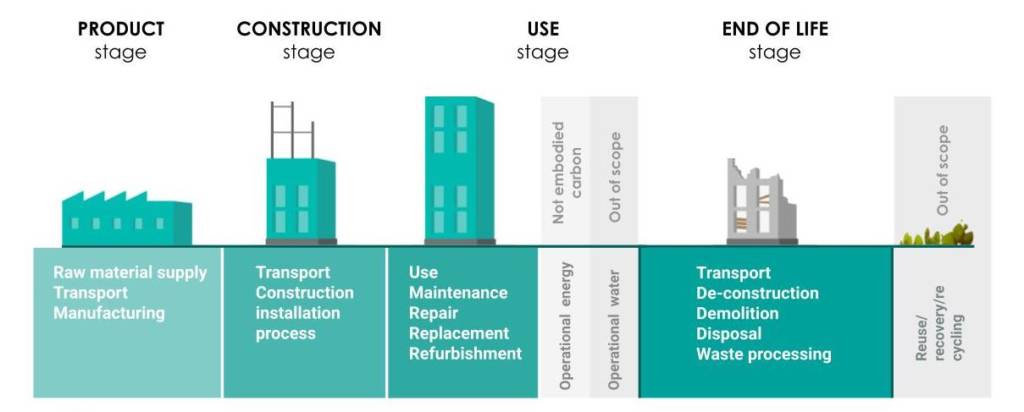As the reality of climate change takes hold, the building sector knows that it is responsible for a large portion of human emissions caused on the planet. With buildings currently responsible for 39% of global carbon emissions, decarbonizing the sector is one of the most cost-effective ways to mitigate the worst effects of climate breakdown. The built environment sector has a critical role to play in addressing the climate emergency.
The entire life cycle of buildings is now under greater scrutiny to determine where emissions can be further reduced. Some of these emissions come from the operation of buildings, and we have known about them for a long time. There is another aspect of buildings and climate change that has only recently been noticed. This is embodied carbon. It has long been a hidden part of a building’s climate impact, as many climate policies and reduction initiatives focus on operational emissions from building use.
Why embodied carbon matters
What is embodied carbon, and why is it an important challenge for the real estate and construction sector? According to the European Commission (2020), embodied carbon relates to “the greenhouse gas emissions associated with the non-operational phase of a project, namely the emissions released through extraction, manufacturing, transportation, assembly, maintenance, replacement, deconstruction, disposal and end of life aspects of the materials and systems that make up a building (cradle to grave).” Embodied carbon is everywhere in the building lifecycle.
According to Architecture 2030, “globally, embodied carbon is responsible for 11% of annual GHG emissions and 28% of building sector emissions. As operational energy efficiency increases, the impact of embodied carbon emissions in buildings will become increasingly significant.” This suggests that the goal of zero emissions by 2050 is not achievable without action on embodied carbon. Because the embodied carbon footprint is so important, learning to work with these numbers is essential.

Where to focus on tackling embodied carbon?
Optimizing the carbon footprint of a building over its lifetime involves finding a balance between reducing embodied carbon and reducing operational emissions. While operational emissions are the amount of carbon emitted during the operation or use of a building, the impact of embodied carbon occurs during construction and renovation and cannot be reduced afterwards. This means that embodied carbon will account for about 50% of the built environment’s emissions by 2035, while operational emissions from buildings will decrease due to the growing global environmental awareness and the current regulatory framework, which is pushing real estate players to reduce their operational emissions.
But this often requires renovation and, therefore, the addition of embodied carbon. Yet the world’s urban population is expected to grow by 2.75 billion people by 2060. Much of the carbon footprint of these new buildings will be in the form of embodied carbon (over 100 gigatonnes of estimated embodied carbon). Actions must be taken to address embodied carbon to meet the European goal of zero emissions by 2050.
Where does the regulation framework stand?
The built environment sector has a key role to play in addressing the climate emergency. Addressing embodied carbon is a critical and urgent issue. The next challenge, particularly for new construction, is implementing an effective net zero strategy. So far, European legislation has focused on reducing greenhouse gas emissions associated with the energy needed to heat, cool, and power a building. While much remains to be done to reduce embodied carbon, this issue has become a priority for industry and governments. The countries with the most progressive operational energy requirements are also those seeking to regulate embodied carbon. Within the European Union, only five countries- Denmark, Finland, France, the Netherlands, and Sweden- have introduced lifecycle carbon emissions regulations that address both operational and embodied emissions.
Focus on the RE2020 in France
One of the best examples to date is the RE2020 in France, which went into effect in January 2022. This regulation introduces new building requirements that aim to reduce emissions from building materials throughout the life of the building, including during demolition. RE2020 goes beyond reducing and decarbonizing a building’s energy consumption. It also aims to promote sustainable, low-carbon building materials. It is an important step in contributing to the national objective of decarbonizing all sectors by 2050 in France.
RE2020 has three main objectives:
- Reduce the carbon impact of existing constructions: The RE2020 aims at lowering by 30% the bioclimatic indicator, the energy needs of a building, compared to the RT2012.
- Reduce the carbon impact of new constructions: By 2031, the maximum threshold in kgCO2/m2 will be lowered by more than 30% compared to the current reference level.
- Buildings more adapted to global warming: Include cooling needs in bioclimatic calculations.
It also defined construction thresholds for single and collective housing by 2031.
- For single housing, 640 kgCO2eq/m2/y of embodied carbon emissions in 2022 to 415 kgCO2eq/m2/y in 2031.
- For collective housing, 740 kgCO2eq/m2/y of embodied carbon emissions in 2022 to 490 kgCO2eq/m2/y in 2031.
As of January 2022, real estate developers in Sweden must calculate the embodied carbon emissions of new buildings before submitting them to the government in order to receive the final building permit. According to the Climate Disclosure Act for new buildings, these calculations must cover so-called direct embodied emissions, taking into account the initial production of materials and the different construction phases of a building’s life cycle. Companies that start measuring embodied carbon in their projects now will improve the skills of their staff, bring about a culture change in the sector, and get ahead of the inevitable regulation.
Reducing embodied carbon in new construction or renovation?
Global warming, particularly in Europe, requires a greater focus on building resilience in the context of increased climate risks. To be net zero, a real estate program must take into account the CO2 emitted not only during the use of the buildings (operational emissions) but also during its construction and the production of materials (embodied emissions). Global environmental awareness is pushing real estate players to reduce their operational emissions. Indeed, this awareness has led to the appearance of environmental standards, certifications, and labels. The building of tomorrow will have to be robust and attractive to all stakeholders: employees, customers, consumers, investors, and shareholders. Today, the supply of net zero buildings is insufficient to meet the demand. But the solution does not necessarily lie in accelerating the construction of this type of building, given the carbon footprint associated with construction.
Read more: Climate risk challenges on the rise: considerations to evaluate your resilience level
Is new construction or operationally efficient renovation the most effective way to reduce overall carbon emissions? With 80% of the 2050 building stock already standing, the need to reduce the impact of operational emissions by renovating existing buildings is clear. Retrofitting existing buildings is critical to the transition to a low-carbon economy. However, the real estate sector can only renovate by taking into account the embodied carbon emitted during these renovation strategies. Indeed, embodied carbon is increased during renovations to reduce operational emissions that are far too high. The key performance indicator of interest to track for this balance is called the amortization period or break-even years: this is the point at which the added embodied carbon is less than the operational carbon savings achieved.
Another challenge for Europe
The European challenge is to continue to reduce the carbon footprint of new buildings on the one hand and, on the other hand, to do low embodied carbon works involving a strong reduction in operational emissions to reduce emissions over the whole life cycle of existing buildings.
On December 15, 2021, the European Commission adopted a major revision of the Energy Performance of Buildings Directive (EPBD) as part of the Fit for 55 package. The EPBD requires Member States to reduce the energy consumption of buildings and that all new buildings from 2021 onwards (public buildings from 2019 onwards) be nearly zero-energy buildings (NZEB). The proposed measures take into account, in particular, the increase in renovation rates, especially for the least efficient buildings in each Member State. They will modernize the building stock, making it more resilient and accessible.
Initially, the recast of the EPBD focused only on energy performance, with requirements that addressed only emissions during the operational phase of buildings. The European Environmental Bureau (EEB) and the Environmental Coalition on Standards (ECOS) advocated for more. They asked for the inclusion of life cycle emissions. Indeed, the proposed revision of the directive now refers to the whole life cycle, which is real progress. The ongoing negotiations on the Energy Performance of Buildings Directive (EPBD) are expected to conclude in the summer of 2023. It represents a unique occasion to broaden the discussion on buildings decarbonization, to include all building emissions, and to put a pragmatic framework in place. It could change the way embodied carbon is addressed at the European level.
Read more: A comparison of regulations, certifications, labels, and ESG scoring in Europe
Embodied carbon has been on a significant upward trend in Europe, although regulators in different European countries are not on the same page. Initial actions by a few member states show that lifecycle carbon policies are possible and wanted. A common approach or framework at the EU level could bring additional benefits and foster widespread adoption of ambitious local, national, and regional policies that will reduce embodied carbon. In the meantime, the current and upcoming work of some European countries will hopefully encourage significant initiatives in the coming years. Because of this general uncertainty, in the absence of clear global guidelines and thresholds, some major players in the sector are leading the way on reduction targets.
Effective measures to reduce embodied carbon in buildings require robust data on current levels of these emissions from different life cycle stages, building types, and energy use. This is where Deepki can help. At Deepki, we look at carbon in a systems approach: operational carbon savings must balance embodied emissions at the end. While the greatest potential for embodied carbon reduction is in the early stages of the process of construction, investors and owners can consider it in their existing assets.



